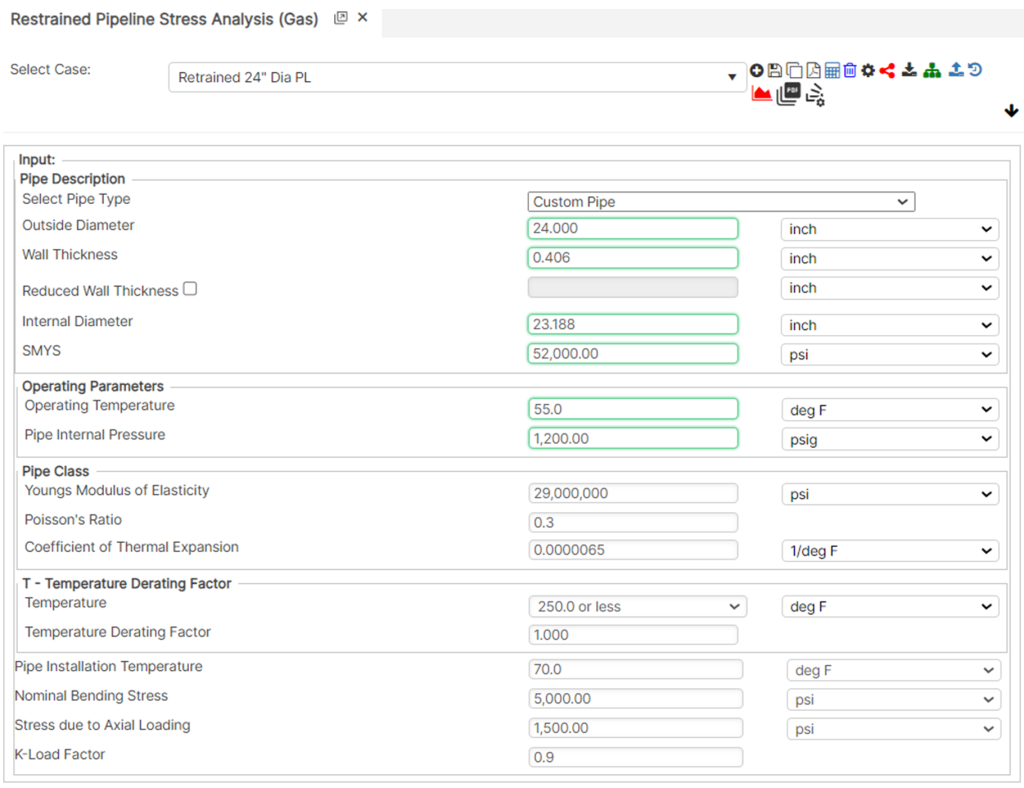Introduction
Restrained pipes are typically buried with proper bedding. However, when settlement or subsidence occurs the longitudinal and combined stresses may be replaced with a strain limit of 2% in ASME B31.4
Yielding that does not impair the serviceability of the pipe. Local stresses caused by periodic or repetitive load resulting in fatigue. Unanticipated earthquakes vibration and thermal expansion.
Hoop Stress
S_H=\frac{PD}{2t}
S_H=\frac{PD}{2t}Where:
𝑆𝐻 − Hoop stress (psi)
𝑃 − Pipe internal pressure (psi)
𝐷 − Pipe outside diameter (in)
𝑡 − Pipe wall thickness (in)
Longitudinal Stress due to Internal Pressure
S_p=0.3S_H
S_p=0.3S_H
Where:
𝑆𝑃 − Longitudinal stress due to internal pressure (psi)
𝑆𝐻 − Hoop stress (psi)
Longitudinal Stress due to Thermal Expansion
S_T=E\alpha(T_1-T_2)
S_T=E\alpha(T_1-T_2)
Where:
𝑆𝑇 − Longitudinal stress due to thermal expansion (psi)
𝛼 − Coefficient of thermal expansion (1/℉)
𝐸 − Elastic modulus of ambient temperature (psi)
𝑇1 − Pipe Temperature at the time of installation (℉)
𝑇2 − The warmest or coldest pipe operating temperature (℉)
Nominal Bending Stress
S_B=\frac{M}{Z}
S_B=\frac{M}{Z}Where:
𝑆𝐵 − Nominal bending stress (lb/in)
𝑀 − Calculated bending moment
𝑍 − Pipe section modulus (in3)
Stress due to Axial Loading
S_X=\frac{R}{A}
S_X=\frac{R}{A}Where:
𝑆𝑋 − Axial loading stress (lb/in)
𝑅 − External for axial component (lb)
𝐴 − Pipe metal cross sectional area (in2)
Net Longitudinal Stresses
S_L=S_P+S_T+S_B+S_X
S_L=S_P+S_T+S_B+S_X
Where:
𝑆𝐿 − Net longitudinal stress in restrained pipe(psi)
Note: The maximum permitted value for 𝑆𝐿 is 0.9ST
𝑆 − Specified minimum yield strength (psi)
𝑇 − Temperature derating factor
Combined Biaxial Stress
S_C=\sqrt{ S_L^2-S_LS_H+S_H^2 }
S_C=\sqrt{ S_L^2-S_LS_H+S_H^2 }Where:
𝑆𝐶 − Combined biaxial stress (psi)
Note: The maximum permitted value of 𝑆𝐶 is 𝑘𝑆𝑇
𝑘 ≤ 0.9 − For load of long duration
𝐾 = 1.0 − For occasional nonperiodic loads of short duration
𝑆 − Specified minimum yield strength (psi)
𝑇 − Temperature derating factor
Case Guide
Part 1: Create Case
- Select the Restrained Pipeline Stress Analysis application from the Design & Stress Analysis Module
- To create a new case, click the “Add Case” button
- Enter Case Name, Location, Date and any necessary notes.
- Fill out all required Parameters.
- Make sure the values you are inputting are in the correct units.
- Click the CALCULATE button to overview results.
Input Parameters
- Nominal Pipe Size (in): (0.625” – 48”)
- Wall Thickness (in): (0.068”- >2”)
- Pipe grade: (24000psi-80000psi) (if unknown use Grade A 24000)
- Pipe Operating Temperature: (-70°F – 160°F)
- Pipe Internal Pressure
- Young’s Modulus of Elasticity: (29000000psi – 30000000psi)
- Poisson’s Ratio: (0.0 – 0.5)
- Thermal Expansion Coefficient (1/°F) : (0.0000022in/inF – 0.000012in/inF)
- T – Temperature Derating Factor
- Pipe Installation Temperature: (-70°F – 160°F)
- Nominal Bending Stress (psi) (Offline Calculation or Estimated Bending Stress)
- Stress due to Axial Load (psi) (Offline Calculation or Estimated Bending Stress)
- k – Load Factor: (1000psi @ 10’-1500psi @ 15’)

Part 2: Outputs/Reports
- If you need to modify an input parameter, click the CALCULATE button after the change.
- To SAVE, fill out all required case details then click the SAVE button.
- To rename an existing file, click the SAVE As button. Provide all case info then click SAVE.
- To generate a REPORT, click the REPORT button.
- The user may export the Case/Report by clicking the Export to Excel icon.
- To delete a case, click the DELETE icon near the top of the widget.
Results
- Hoop Stress (psi)
- Longitudinal Stress due to Internal Pressure (psi)
- Longitudinal Stress due to Thermal Expansion (psi)
- Net Longitudinal Stress (psi)
- Maximum Permitted Longitudinal Stress (psi)
- Combined Biaxial Stress (psi)
- Maximum Permitted Combined Biaxial Stress (psi)

References
- ASME B31.8 – Gas Transmission and Distribution Piping Systems
- API 5L, API 5LS and API 5LX – Specification of Pipe Grade
- ASTM – Various – Weld Joint Factor
- CFR Code Part 192
- USDA-SCS Modified (Permissible Velocity of Water and Soil Erodibility)
- FHWA-HEC
- Pipeline Rules of Thumb Handbook
- Timoshenko, S – Theory of Elasticity Anchor Force
FAQ
-
Restrained versus Unrestrained Pipe (Difference in Gas vs. Liquid)?
ASME B31.4 liquid and B31.8 gas codes include calculations for the net longitudinal compressive stress that must be applied only for a restrained line that equates to a low (less than 2%) longitudinal strain. This stress status is characteristic to underground pipelines located some distance away from above ground piping facilities.
Unrestrained lines means those above ground sections of piping without axial restraint as with buried pipe with soil. In others words the soil exerts substantial axial restraint, but not fully restrained. Check Out
-
What is the Maximum Span Length of rev1?
Regarding span factors with and without water are based on bending stress and deflection. Larger diameter pipe spans require saddles for stability. Many standards that require pipes to be filled with water are based on bending and shear stresses not to exceed 1,500 psi and a deflection between supports not exceed 0.1 inches. Check Out
-
What is the model used for Thrust at Blow-Off?
